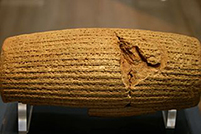Christians traditionally claim that the suffering, death, and resurrection of Jesus is prefigured in Isaiah’s Suffering Servant. This interpretation originates in the New Testament. Some may wonder if the New Testament writers invented the idea, but it is based on a tradition of interpretation stretching back to Isaiah itself.
Where does the Suffering Servant appear in Isaiah and Jewish tradition?
The Suffering Servant appears in Isa 50, Isa 52, Isa 53. These chapters are part of a section of Isaiah written to a community in exile, devastated by the loss of their national and covenant identity (Isa 40-55). The speaker announces that the debt of Israel’s sin leading to their exile in Babylon has been paid and that God is coming to redeem the people with a fresh manifestation of power. God’s chosen Servant plays a role in this redemption (Isa 42, Isa 49). That role culminates in the image of the Suffering Servant, whose suffering, vindication, and exaltation accomplish Israel’s redemption and the Lord’s universal reign (Isa 50, Isa 52, Isa 53).
For centuries afterwards, biblical and extrabiblical writers read these chapters and reimagined them for their own times. First, the postexilic writer of Isa 54, Isa 56-66 applied what was said in Isa 40-55 to an unnamed individual of his own time and to a group of mourners, or “servants,” who were to extend the Servant’s mission in the face of opposition as they waited for God’s coming (e.g., Isa 61:1-66:24). Then, later communities seeking to explain experiences of trauma in spite of their covenant obedience followed this lead. The Suffering Servant provided a pattern for describing the suffering of righteous individuals and groups in Daniel (Dan 11:32-33; Dan 12:1-2), the Wisdom of Solomon (Wis 3:1-9), 2Macc 7, and the Dead Sea scrolls (1QHa 12.23; 1QHa 15.5–6; 16.26–27; 4Q427 7.2.7–9). The Suffering Servant thus proved to be a powerful and lasting image for Second Temple Jews seeking to explain their experiences in light of their scriptures: just as the Suffering Servant was vindicated and exalted, so would the suffering righteous be.
How do the New Testament Writers interpret the Suffering Servant?
Following this interpretive tradition, New Testament writers look to the Suffering Servant to explain the mission and suffering of Jesus and his followers. For instance, the gospels explicitly say that Jesus’s ministry fulfils the description of the Suffering Servant in Isaiah: Jesus’s acts of healing (Matt 8:17 // Isa 53:4); peoples’ persistent unbelief in him (John 12:38 // Isa 53:1; also Rom 10:16-17 // Isa 53:1); his arrest (Luke 22:37 // Isa 53:12); and his humiliation (Acts 8:32-35 // Isa 53:7-8). The New Testament also uses language from Isa 52, Isa 53 implicitly. For instance, the gospels present Jesus as the one who has come to “serve” and give his life as a ransom for “many” and describes Jesus’s disciples as “servants” who imitate his example (Matt 20:25-28; Mark 10:41-45 // Isa 53:10-11). Elsewhere, writers cloak their description of Jesus’s suffering, death, and exaltation in language about the Suffering Servant, as an example for believers to follow (1Pet 2:21-25// Isa 53:4-6, Isa 53:9; Phil 2:5-11 / /Isa 52, Isa 53).
New Testament writers seeking to understand both Jesus’s suffering and their own saw the Suffering Servant not only as a pattern but also the fulfilment of God’s promises. This presentation has fuelled the Christian imagination ever since.
Bibliography
- Blenkinsopp, Joseph. Opening the Sealed Book: Interpretations of the Book of Isaiah in Late Antiquity. Grand Rapids, MI: Eerdmans, 2006.
- Stromberg, J. “Servant of God.” In The Oxford Encyclopedia of the Bible and Theology. Edited by S. E. Balentine. Oxford: Oxford University Press, 2015.
- Stuhlmacher, Peter, and Bernd Janowski, eds. The Suffering Servant: Isaiah 53 in Jewish and Christian Sources. Grand Rapids, MI: Eerdmans, 2004.





